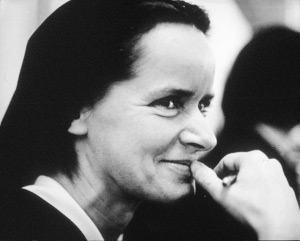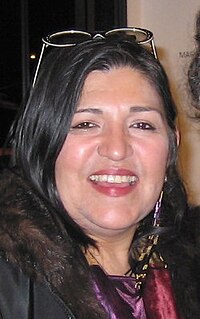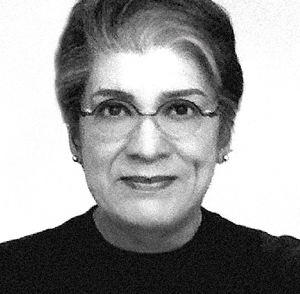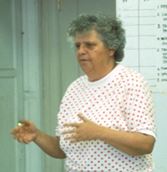Related Research Articles
Barbara Kruger is an American conceptual artist and collagist associated with the Pictures Generation. She is most known for her collage style that consists of black-and-white photographs, overlaid with declarative captions, stated in white-on-red Futura Bold Oblique or Helvetica Ultra Condensed text. The phrases in her works often include pronouns such as "you", "your", "I", "we", and "they", addressing cultural constructions of power, identity, consumerism, and sexuality. Kruger's artistic mediums include photography, sculpture, graphic design, architecture, as well as video and audio installations.

Corita Kent, born Frances Elizabeth Kent and also known as Sister Mary Corita Kent, was an American artist, designer and educator, and former religious sister. Key themes in her work included Christianity, and social justice. She was also a teacher at the Immaculate Heart College.

Carlos D. Almaraz was a Mexican-American artist and a pioneer of the Chicano art movement.

April Greiman is an American designer widely recognized as one of the first designers to embrace computer technology as a design tool. Greiman is also credited, along with early collaborator Jayme Odgers, with helping to import the European New Wave design style to the US during the late 70s and early 80s." According to design historian Steven Heller, “April Greiman was a bridge between the modern and postmodern, the analog and the digital.” “She is a pivotal proponent of the ‘new typography’ and new wave that defined late twentieth-century graphic design.” Her art combines her Swiss design training with West Coast postmodernism.

Self-Help Graphics & Art, Inc. is a community arts center with a mix Beaux-Arts and vernacular architecture in East Los Angeles, California, United States. The building was built in 1927, and was designed by Postle & Postle. Formed during the cultural renaissance that accompanied the Chicano Movement, Self Help, as it is sometimes called, was one of the primary centers that incubated the nascent Chicano art movement, and remains important in the Chicano art movement, as well as in the greater Los Angeles community, today. SHG also hosts musical and other performances, and organizes Los Angeles's annual Day of the Dead festivities. Throughout its history, the organization has worked with well-known artists in the Los Angeles area such as Los Four and the East Los Streetscapers, but it has focused primarily on training and giving exposure to young and new artists, many of whom have gone on to national and international prominence.
The Woman's Building was a non-profit arts and education center located in Los Angeles, California. The Woman's Building focused on feminist art and served as a venue for the women's movement and was spearheaded by artist Judy Chicago, graphic designer Sheila Levrant de Bretteville and art historian Arlene Raven. The center was open from 1973 until 1991. During its existence, the Los Angeles Times called the Woman's Building a "feminist mecca."
Cheri Gaulke is a visual artist most known for her role in the Feminist Art Movement in southern California in the 1970s and her work on gay and lesbian families.
Alison Saar is a Los Angeles, California based sculptor, mixed-media, and installation artist. Her artwork focuses on the African diaspora and black female identity and is influenced by African, Caribbean, and Latin American folk art and spirituality. Saar is well known for "transforming found objects to reflect themes of cultural and social identity, history, and religion."

The feminist art movement in the United States began in the early 1970s and sought to promote the study, creation, understanding and promotion of women's art. First-generation feminist artists include Judy Chicago, Miriam Schapiro, Suzanne Lacy, Judith Bernstein, Sheila de Bretteville, Mary Beth Edelson, Carolee Schneeman, Rachel Rosenthal, and many other women. They were part of the Feminist art movement in the United States in the early 1970s to develop feminist writing and art. The movement spread quickly through museum protests in both New York and Los Angeles, via an early network called W.E.B. that disseminated news of feminist art activities from 1971 to 1973 in a nationally circulated newsletter, and at conferences such as the West Coast Women's Artists Conference held at California Institute of the Arts and the Conference of Women in the Visual Arts, at the Corcoran School of Art in Washington, D.C..

Linda Vallejo is an American artist known for painting, sculpture and ceramics. Her work often addresses her Mexican-American ethnic identity within the context of American art and popular culture. The founder of the commercial art gallery Galería Las Américas, she is also an arts educator and has been involved intraditional Native American and Mexican rituals and ceremonies for many years.

Judithe Hernández is an American artist and educator, she is known as a muralist, pastel artist, and painter. She a pioneer of the Chicano art movement and a former member of the art collective Los Four. She is based in Los Angeles, California and previously lived in Chicago.
Virginia Dwan is an American art collector, art patron, philanthropist, visionary and founder of the Dwan Light Sanctuary in Montezuma, New Mexico. She is the former owner and executive director of Dwan Gallery, Los Angeles (1959–1967) and Dwan Gallery New York (1965–1971), a contemporary art gallery closely identified with the American movements of Minimalism, Conceptual Art, and Earthworks.

Nancy Buchanan is a Los Angeles-based artist best known for her work in installation, performance, and video art. She played a central role in the feminist art movement in Los Angeles in the 1970s. Her work has been exhibited widely and is collected by major museums including the Museum of Modern Art and the Centre Pompidou.

Andrea Bowers is a Los Angeles-based American artist working in a variety of media including video, drawing, and installation. Her work has been exhibited around the world, including museums and galleries in Germany, Greece, and Tokyo. Her work was included in the 2004 Whitney Biennial and 2008 California Biennial. She is on the graduate faculty at Otis College of Art and Design.

Karen Boccalero was an American nun, fine artist, and founder and former director of Self-Help Graphics & Art.

Sheila Pinkel is an American visual artist, activist and educator whose practice includes experimental light studies, photography, conceptual and graphic works, and public art. She first gained notice for cameraless photography begun in the 1970s that used light-sensitive emulsions and technologies to explore form; her later, socially conscious art combines research, data visualization, and documentary photography, making critical and ethical inquiries into the military-industrial complex and nuclear industry, consumption and incarceration patterns, and the effects of war on survivors, among other subjects. Writers identify an attempt to reveal the unseen—in nature and in culture—as a common thread in her work.
Erika Rothenberg is a Los Angeles based artist whose artistic practice consists of drawing, installation and public art. Known for their humor and directness, her text-based works typically play with mechanisms of display and communication.
Jane Norling is a visual artist active in San Francisco Bay Area cultural venues since 1970. Her work addresses social & environmental justice and aesthetic concerns through public art, graphic design, painting, printmaking & small press publishing. She graduated from Bennington College in 1968 with a Bachelor of Arts in Visual Arts and began her career designing books at Random House before relocating to San Francisco in 1970.
Garland Kirkpatrick is an American designer, educator, and curator based in Los Angeles.
Felicia “Fe” Montes is a Xicana indigenous artist working and living in Los Angeles who is dedicated to spreading the message of women and indigenous empowerment through arts activism. Montes is a multimedia artist, poet, performer, educator, professor, and emcee. She is the co-founder and coordinating member of two creative woman's collectives, Mujeres de Maiz and In Lak Ech and El MERCADO y Mas. She also assists with organizing transnational art exhibitions including Zapatistas, Peace Dignity Journeys and La Red Xicana Indigena.
References
- ↑ "If there is a value in radical archives, archival practice, or archival content, what is it and how do you achieve and maintain it? If not, why not?". Archive Journal. Retrieved 4 October 2016.
- ↑ MacPhee, Josh. "New Online Exhibitions from CSPG". Justseeds. Retrieved 4 October 2016.
- ↑ Heller, Steven. "Power to the Paper: An Interview with Carol Wells" (PDF). AIGA Journal of Design. Retrieved 7 October 2016.
- ↑ "Collectors in Conversation Continues with Social Justice Art Historian Carol A. Wells". In Focus. Pasadena Now. Retrieved 7 October 2016.
- ↑ "Monomania L.A.: Carol Wells and the Politics of Postering". Link TV. Retrieved 7 October 2016.
- ↑ "Creative Action: Political Graphics Archive". Otis College of Art and Design. Retrieved 7 October 2016.
- ↑ "Gallery Guide". Otis College of Art and Design. Retrieved 7 October 2016.
- ↑ Ochoa, Laurie. "She Saves Posters for Sake of History, Art". L.A. Times. Retrieved 7 October 2016.
- ↑ Pool, Bob. "Protest Posters Find Asylum With Activist". L.A. Times. L.A. Times. Retrieved 7 October 2016.
- ↑ Sheff, Harry. "The Center for the Study of Political Graphics". Utne Reader. Retrieved 4 October 2016.
- ↑ "Center for the Study of Political Graphics". Online Archives of California.
- ↑ Futch, David. "85,000 of the World's Angriest Political Posters Are Sitting in Culver City". L.A. Weekly. Retrieved 1 October 2016.
- ↑ EDWARDS (Host), BOB (Mar 13, 1996). "L.A. SHOW HANGS VIETNAMESE, U.S. AND CUBAN WAR POSTERS". Accessed through ProQuest. (Morning Edition).
- ↑ "Artists, Institutions Receive Getty Trust Grants". L.A. Times. Retrieved 4 October 2016.
- ↑ "Our Funders". Center for the Study of Political Graphics. Retrieved 4 October 2016.
- ↑ "The Art of Protest". L.A. Times. Retrieved 4 October 2016.
- ↑ "Political posters make bold statements". L.A. Times. Retrieved 4 October 2016.
- ↑ Lavin, Enrique. "Community News: South-Central: Posters Trace History of Black Panthers". L.A. Times. Retrieved 7 October 2016.
- ↑ "Too Hot to Handle: Speaker Panel + Tour". evnsi. Archived from the original on 9 October 2016. Retrieved 7 October 2016.
- ↑ "Exhibition Guide". Center for the Study of Political Graphics. Retrieved 7 October 2016.
- ↑ YOON, EDWARD M. "Exhibit Looks at Sexism, Homophobia". L.A. Times. Retrieved 7 October 2016.
- ↑ "Exhibition Guide". Center for the Study of Political Graphics. Retrieved 7 October 2016.